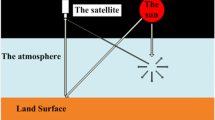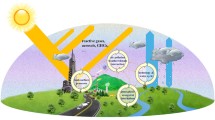Abstract
Arid and semi-arid areas comprise about 30% of the earth’s surface. Changes in climate and climate variability will likely have a significant impact on these regions. The Loess Plateau over Northwest China is a special semi-arid land surface and part of a dust aerosol source. To improve understanding and capture the direct evidence of the impact of human activity on the semi-arid climate over the Loess Plateau, the Semi-Arid Climate and Environment Observatory of Lanzhou University (SACOL) was established in 2005. SACOL consists of a large set of instruments and focuses on: (1) monitoring of long term tendencies in semiarid climate changes; (2) monitoring of the aerosol effect on the water cycle; (3) studies of interaction between land surface and the atmosphere; (4) improving the land surface and climate models; and (5) validation of space-borne observations. This paper presents a description of SACOL objectives, measurements, and sampling strategies. Preliminary observation results are also reviewed in this paper.
Similar content being viewed by others
References
Alexandrov, M. D., A. A. Lacis, B. E. Carlson, and B. Cairns, 1999: Remote sensing of atmospheric aerosols, nitrogen dioxide, and ozone by means of multi-filter rotating shadow-band radiometer. Remote Sensing of Clouds and Atmosphere, J. Russell, and C. Serio, Eds., Proc. SPIE 3867, 156–170.
Bao, Y., and S. Lu, 2006: Review of land-atmosphere interaction research in Arid and Semi-arid regions. Journal of Desert Research, 3, 134–140. (in Chinese)
Breon, F.-M., D. Tanre, and S. Generoso, 2002: Aerosol effect on cloud droplet size monitored from satellite. Science, 295, 834–838.
Chambers, L. H., B. Lin, and D. F. Young, 2002: Examination of new CERES data for evidence of tropical iris feedback. J. Climate, 15, 3719–3726.
Chinese Editorial Committee of Soil Analysis, 1996: Soil Physical and Chemical Analysis and Description of Soil Profile. China State Standards Press, 266pp. (in Chinese)
Crowley, T. J., 2000: Causes of climate change over the past 1000 years. Science, 289, 270–277.
DeMott, P. J., K. Sassen, M. Poellot, D. Baumgardner, D. C. Rogers, S. Brooks, A. J. Prenni, and S. M. Kreidenweis, 2003: African dust aerosols as atmospheric ice nuclei. Geophys. Res. Lett., 30, 1732, doi:10.1029/2003GL017410.
Foken, T., M. Göckede, M. Mauder, L. Mahrt, B. D. Amiro, and J. W. Munger, 2004: Post-field data quality control. Handbook of Micrometeorology: A Guide for Surface Flux Measurements, Lee et al., Eds., Kluwer, 181–208.
Harrison, L., and J. Michalsky, 1994: Objective algorithms for the retrieval of optical depths from ground-based measurements. Appl. Opt., 33, 5126–5132.
Harrison, L., J. Michalsky, and J. Berndt, 1994: Automated multifilter rotating shadow-band radiometer: An instrument for optical depth and radiation measurements. Appl. Opt., 33, 5118–5125.
Holben, B. N., and Coauthors, 1998: AERONET—A federated instrument network and data archive for aerosol characterization. Remote Sens. Environ., 66, 1–16.
Houghton, J. T., Y. Ding, D. J. Griggs, M. Noguer, P. J. van der Linden, and D. Xiaosu, 2001: Climate Change 2001: The Scientific Basis. Cambridge University Press, 944pp.
Hu, Y., 1994: Research advance about the energy budget and transportation of water vapor in the HEIFE area. Advance in Earth Sciences, 9, 30–34. (in Chinese)
Hu, Y., and Y. Gao, 1994: Some new understandings of processes at the land surface in arid area from the HEIFE. Acta Meteorologica Sinica, 52, 285–296. (in Chinese)
Huang, J. P., B. Lin, P. Minnis, T. Wang, X. Wang, Y. Hu, Y. Yi, and J. R. Ayers, 2006a: Satellite-based assessment of possible dust aerosols semi-direct effect on cloud water path over East Asia. Geophys. Res. Lett., 33, doi: 10.1029/2006GL026561.
Huang, J. P., P. Minnis, B. Lin, T. Wang, Y. Yi, Y. Hu, S. Sun-Mack, and K. Ayers, 2006b: Possible influences of Asian dust aerosols on cloud properties and radiative forcing observed from MODIS and CERES. Geophys. Res. Lett., 33, L06824, doi: 10.1029/2005GL024724.
Huang, R., 2004: Advances of the project of the formation mechanism and p theory of severe climatic disasters in China. China Basic Science, 4, 6–16. (in Chinese)
Iwasaka, Y., and Coauthors, 2003: Nature of atmospheric aerosols over the desert areas in the Asian continent: chemical state and number concentration of particles measured at DunHuang, China. Water, Air, and Soil Pollution: Focus, 3, 129–145.
Iwasaka, Y., and Coauthors, 2004: Pool of the dust particles over the Asian continent, balloon-borne optical particle counter and ground-based lidar measurements at Dunhuang, China. Environmental Monitoring and Assessment, 92, 5–24.
Janssens, I. A., A. S. Kowalski, B. Longdoz, and R. Ceulemans, 2000: Assessing forest soil CO2 efflux: An in situ comparison of four techniques. Tree Physiology, 20, 23–32.
Kawamoto, K., and T. Nakajima, 2003: Seasonal variation of cloud particle size from AVHRR remote sensing. Geophys. Res. Lett., 30, 1810–1813.
Liu, H., W. Dong, C. Fu, and L. Shi, 2004: The long-term field experiment on aridification and the ordered human activity in semi-arid area at Tongyu, Northeast China. Climatic and Environmental Research, 9, 352–378. (in Chinese)
Lu, D., and Coauthors, 2002: Composite study on Inner Mongolia semiarid grassland soil-vegetationatmosphere interaction (IMGRASS). Earth Science Frontiers, 9, 52–63. (in Chinese)
Lu, D., Z. Chen, J. Chen, G. Wang, J. Ji, H. Chen, and Z. Liu, 2005: Study on soil-vegetation-atmosphere interaction in Inner Mongolia semiarid grassland. Acta Meteorologica Sinica, 63, 33–55. (in Chinese)
Mann, M. E., R. S. Bradley, and M. K. Hughes, 1999: Northern hemisphere temperatures during the past millennium: inferences, uncertainties, and limitations. Geophys. Res. Lett., 26, 759–762.
Massman, W. J., 2000: A simple method for estimating frequency response corrections for eddy covariance systems. Agricultural Forest Meteorology, 104, 185–198.
Massman, W. J., 2001: Reply to comment by Rannik on “A simple method for estimating frequency response corrections for eddy covariance systems”. Agricultural Forest Meteorology, 107, 247–251.
Min, Q. 1996: Cloud properties derived from surface MFRSR measurements and comparison with GOES results at the ARM SGP site. Geophys. Res. Lett., 23, 1641–1644.
Moore, C. J., 1986: Frequency response corrections for eddy correlation systems. Bound.-Layer Meteorol., 37, 17–36.
Ramanathan, V., P. J. Crutzen, J. T. Kiehl, and D. Rosenfeld, 2001: Aerosols, climate, and the hydrological cycle. Science, 294, 2119–2124.
Ren, J. Z., 1998: Research Method of Prataculturae Science. Chinese Agriculture Press, 441pp. (in Chinese)
Rosenfeld, D., Y. Rudich, and R. Lahav, 2001: Desert dust suppressing precipitation: A possible desertification feedback loop. Proceedings of the National Academy of Sciences, 98, 5975–5980.
Schotanus, P., F. T. M. Nieuwstadt, and H. A. R. De Bruin, 1983: Temperature measurement with a sonic anemometer and its application to heat and moisture fluctuations. Bound.-Layer Meteor., 26, 81–93.
Twomey, S., 1977: Influence of pollution on shortwave albedo of clouds. J. Atmos. Sci., 34, 1149–1152.
Webb, E. K., Pearman, G. I., and R. Leuning, 1980: Correction of flux measurements for density effects due to heat and water vapour transfer. Quart. J. Roy. Meteor. Soc., 106, 85–100.
Welton, E. J., J. R. Campbell, J. D. Spinhirne, and V. S. Scott, 2001: Global monitoring of clouds and aerosols using a network of micropulse lidar systems. Vol. 4153, Proc. Lidar Remote Sensing for Industry and Environmental Monitoring, Sendai, Japan, SPIE, 151–158.
Wilczak, J. M., S. P. Oncley, and S. A. Stage, 2001: Sonic anemometer tilt correction algorithms. Bound.-Layer Meteor., 99, 127–150.
Zhang, H. S., J. Y. Chen, and S.-U. Park, 2001: Turbulence structure in the unstable condition over various surfaces. Bound.-Layer Meteor., 100, 243–261.
Zhang, Q., and Coauthors, 2005: NWC-ALIEX and its advances. Advance in Earth Sciences, 20, 60–74. (in Chinese)
Author information
Authors and Affiliations
Corresponding author
Rights and permissions
About this article
Cite this article
Huang, J., Zhang, W., Zuo, J. et al. An overview of the Semi-arid Climate and Environment Research Observatory over the Loess Plateau. Adv. Atmos. Sci. 25, 906–921 (2008). https://doi.org/10.1007/s00376-008-0906-7
Received:
Revised:
Published:
Issue Date:
DOI: https://doi.org/10.1007/s00376-008-0906-7




